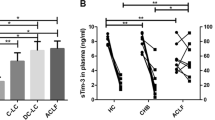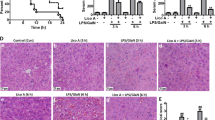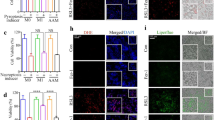Abstract
Regulating the immune-environment is essential for treating acute liver injury (ALI). However, the deficiency of an effective immune balancer restricted progress. Herein, we reported an oligosaccharide from Fructus lycii oligosaccharide (FLO). To investigate the effects of FLO, we adopted primary macrophages and LO2 for experiments in vitro. In vivo, we assessed the influence of FLO in ALI with histochemical staining and enzyme indicators detection. Following that, we clarified the underlying mechanisms using western blotting and immunofluorescence. Our results indicated that FLO (100 μg/mL) showed apparent inflammatory reversal effects by shifting the phenotype of macrophages from M1 to M2 without causing any cytotoxicity. Furthermore, CCl4-induced mice were significantly improved by FLO intragastric administration. Meanwhile, PI3K/AKT/mTOR pathway was confirmed for the up-regulation of IL-10 via M2 polarization of macrophages. Collectively, our findings highlight the beneficial effects of FLO on ALI therapy via M1 to M2 macrophage conversion.






Similar content being viewed by others
Data availability
Raw datasets used during the current study are stored and available from the corresponding author on reasonable request.
Abbreviations
- ALI:
-
Acute liver injury
- ALT:
-
Alanine transaminase
- AST:
-
Aspartate transaminase
- BSA:
-
Bovine serum albumin
- DDW:
-
Double distill water
- FBS:
-
Fetal bovine serum
- FLO:
-
Fructus lycii oligosaccharide
- FLP:
-
Fructus lycii polysaccharide
- FLS:
-
Fructus lycii saccharide
- FT-IR:
-
Fourier transform infrared spectroscopy
- H&E,:
-
Hematoxylin and eosin
- HPLC:
-
High-performance liquid chromatography
- HRP:
-
Horseradish peroxidase
- iNOS:
-
Inducible nitric oxide synthase
- LO2 :
-
Human normal liver cells
- LPS:
-
Lipopolysaccharide
- NMR-C:
-
Nuclear magnetic resonance-C
- NMR-H:
-
Nuclear magnetic resonance-H
- PBS:
-
Phosphate buffer solution
- PFA:
-
Paraformaldehyde
- PVDF:
-
Polyvinylidene difluoride
- SPF:
-
Specific pathogen free
- UPLC-DAD-MS/MS:
-
High-performance liquid chromatography coupled with diode-array detection and electrospray ionization tandem mass spectrometry
References
Trefts E, Gannon M, Wasserman DH. The liver. Curr Biol. 2017;27(21):R1147–51.
Xu L, Liu J, Lu M, Yang D, Zheng X. Liver injury during highly pathogenic human coronavirus infections. Liver Int. 2020;40(5):998–1004.
Chang L, Xu D, Zhu J, Ge G, Kong X, Zhou Y. Herbal therapy for the treatment of acetaminophen-associated liver injury: recent advances and future perspectives. Front Pharmacol. 2020;11:313.
De Santa F, Vitiello L, Torcinaro A, Ferraro E. The role of metabolic remodeling in macrophage polarization and its effect on skeletal muscle regeneration. Antioxid Redox Signal. 2019;30(12):1553–98.
Muñoz J, Akhavan NS, Mullins AP, Arjmandi BH. Macrophage polarization and osteoporosis: a review. Nutrients. 2020;12(10):2999.
Cheng P, Li S, Chen H. Macrophages in lung injury, repair, and fibrosis. Cells. 2021;10(2):436.
Saradna A, Do DC, Kumar S, Fu Q-L, Gao P. Macrophage polarization and allergic asthma. Transl Res. 2018;191.
Jin M, Huang Q, Zhao K, Shang P. Biological activities and potential health benefit effects of polysaccharides isolated from Lycium barbarum L. Int J Biol Macromol. 2013;54:16–23.
Masci A, Carradori S, Casadei MA, et al. Lycium barbarum polysaccharides: extraction, purification, structural characterisation and evidence about hypoglycaemic and hypolipidaemic effects. A review. Food Chem. 2018;254:377–89.
Zhang F, Zhang X, Gu Y, et al. Hepatoprotection of lycii fructus polysaccharide against oxidative stress in hepatocytes and larval zebrafish. Oxid Med Cell Longev. 2021;2021:3923625.
Cheng D, Kong H. The effect of Lycium barbarum polysaccharide on alcohol-induced oxidative stress in rats. Molecules. 2011;16(3):2542–50.
Xiao J, Liong EC, Ching YP, et al. Lycium barbarum polysaccharides protect mice liver from carbon tetrachloride-induced oxidative stress and necroinflammation. J Ethnopharmacol. 2012;139(2):462–70.
Manthey AL, Chiu K, So K-F. Effects of Lycium barbarum on the visual system. Int Rev Neurobiol. 2017;135:1–27.
Zheng Y, Pang X, Zhu X, et al. Lycium barbarum mitigates radiation injury via regulation of the immune function, gut microbiota, and related metabolites. Biomed Pharmacother = Biomed Pharmacother. 2021;139:111654.
Xiao Z, Deng Q, Zhou W, Zhang Y. Immune activities of polysaccharides isolated from Lycium barbarum L. What do we know so far? Pharmacol Ther. 2022;229:107921.
Chen X, Fu X, Huang L, Xu J, Gao X. Agar oligosaccharides: a review of preparation, structures, bioactivities and application. Carbohydr Polym. 2021;265:118076.
Courtois J. Oligosaccharides from land plants and algae: production and applications in therapeutics and biotechnology. Curr Opin Microbiol. 2009;12(3):261–73.
Sun Y, Diao F, Niu Y, et al. Apple polysaccharide prevents from colitis-associated carcinogenesis through regulating macrophage polarization. Int J Biol Macromol. 2020;161:704–11.
Li X-Y, Wang Y-J, Chen S, et al. Polysaccharide suppresses atherosclerosis via regulating autophagy-mediated macrophage polarization. J Agric Food Chem. 2022;70(12):3633–43.
Zhao S-J, Kong F-Q, Jie J, et al. Macrophage MSR1 promotes BMSC osteogenic differentiation and M2-like polarization by activating PI3K/AKT/GSK3β/β-catenin pathway. Theranostics. 2020;10(1):17–35.
Gao Z, Yuan F, Li H, et al. The ameliorations of Ganoderma applanatum residue polysaccharides against CCl induced liver injury. Int J Biol Macromol. 2019;137:1130–40.
Zeng P, Li J, Chen Y, Zhang L. The structures and biological functions of polysaccharides from traditional Chinese herbs. Prog Mol Biol Transl Sci. 2019;163:423–44.
Gao Y, Wei Y, Wang Y, Gao F, Chen Z. Lycium barbarum: a traditional Chinese herb and a promising anti-aging agent. Aging Dis. 2017;8(6):778–91.
Liu R-J, He Y-J, Liu H, Zheng D-D, Huang S-W, Liu C-H. Protective effect of Lycium barbarum polysaccharide on di-(2-ethylhexyl) phthalate-induced toxicity in rat liver. Environ Sci Pollut Res Int. 2021;28(18):23501–9.
Xu J-L, Liu Z-F, Zhang X-W, Liu H-L, Wang Y. Microbial oligosaccharides with biomedical applications. Mar Drugs. 2021;19(6):350.
Triantis V, Bode L, van Neerven RJJ. Immunological effects of human milk oligosaccharides. Front Pediatr. 2018;6:190.
Mannino MH, Zhu Z, Xiao H, Bai Q, Wakefield MR, Fang Y. The paradoxical role of IL-10 in immunity and cancer. Cancer Lett. 2015;367(2):103–7.
Oft M. Immune regulation and cytotoxic T cell activation of IL-10 agonists — preclinical and clinical experience. Semin Immunol. 2019;44:101325.
Oft M. IL-10: master switch from tumor-promoting inflammation to antitumor immunity. Cancer Immunol Res. 2014;2(3):194–9.
Li B, Alli R, Vogel P, Geiger TL. IL-10 modulates DSS-induced colitis through a macrophage-ROS-NO axis. Mucosal Immunol. 2014;7(4):869–78.
Silawal S, Willauschus M, Schulze-Tanzil G, Gögele C, Geßlein M, Schwarz S. IL-10 could play a role in the interrelation between diabetes mellitus and osteoarthritis. Int J Mol Sci. 2019;20(3):768.
Shamskhou EA, Kratochvil MJ, Orcholski ME, et al. Hydrogel-based delivery of Il-10 improves treatment of bleomycin-induced lung fibrosis in mice. Biomaterials. 2019;203:52–62.
Mazer M, Unsinger J, Drewry A, et al. IL-10 has differential effects on the innate and adaptive immune systems of septic patients. J Immunol. 2019;203(8):2088–99.
Mollazadeh H, Cicero AFG, Blesso CN, Pirro M, Majeed M, Sahebkar A. Immune modulation by curcumin: the role of interleukin-10. Crit Rev Food Sci Nutr. 2019;59(1):89–101.
Xu Y, Li Y, Liu X, et al. SPIONs enhances IL-10-producing macrophages to relieve sepsis via Cav1-Notch1/HES1-mediated autophagy. Int J Nanomed. 2019;14:6779–97.
Park HJ, Lee SJ, Cho J, et al. Tamarixetin exhibits anti-inflammatory activity and prevents bacterial sepsis by increasing IL-10 production. J Nat Prod. 2018;81(6):1435–43.
Li J, Huang L, Yu L-T, et al. Feruloylated oligosaccharides alleviate central nervous inflammation in mice following spinal cord contusion. J Agric Food Chem. 2020;68(52):15490–500.
Fang H-Y, Chen Y-K, Chen H-H, Lin S-Y, Fang Y-T. Immunomodulatory effects of feruloylated oligosaccharides from rice bran. Food Chem. 2012;134(2):836–40.
Yu Q, Liao M, Sun C, et al. LBO-EMSC hydrogel serves a dual function in spinal cord injury restoration the PI3K-Akt-mTOR pathway. ACS Appl Mater Interfaces. 2021;13(41):48365–77.
Acknowledgements
The authors thank Wentao Shi for his technical assistance and Ziyue Liu for collecting samples. We appreciated for the guidance provided from Ethics Committee in Jiangsu university in the animal experiments.
Funding
This work was financially supported by the Natural Science Foundation of Jiangsu Province (BK20220529). Experiments were conducted at School of Medicine in Jiangsu University.
Author information
Authors and Affiliations
Contributions
Zhe Wang: investigation, supervision, formal analysis, methodology, writing — original draft. Xingxing Zhang: formal analysis, methodology, writing — original draft. Deming Lv: resources, writing — review and editing. Sucheng Cao: methodology, validation. Guang Yang: writing — review and editing, formal analysis. Zhijian Zhang: conceptualization, project administration, funding acquisition, supervision. Qingtong Yu: conceptualization, methodology, writing — review and editing, investigation, funding acquisition.
Corresponding authors
Ethics declarations
Ethics approval
All procedures performed in studies were in accordance with the ethical standards of the institutional and/or national research committee.
Consent to participate
Not applicable.
Consent for publication
Not applicable.
Conflict of interest
The authors declare no competing interests.
Additional information
Publisher's Note
Springer Nature remains neutral with regard to jurisdictional claims in published maps and institutional affiliations.
Rights and permissions
Springer Nature or its licensor (e.g. a society or other partner) holds exclusive rights to this article under a publishing agreement with the author(s) or other rightsholder(s); author self-archiving of the accepted manuscript version of this article is solely governed by the terms of such publishing agreement and applicable law.
About this article
Cite this article
Wang, Z., Zhang, X., Lv, D.m. et al. Fructus lycii oligosaccharide alleviates acute liver injury via PI3K/Akt/mTOR pathway. Immunol Res 72, 271–283 (2024). https://doi.org/10.1007/s12026-023-09431-y
Received:
Accepted:
Published:
Issue Date:
DOI: https://doi.org/10.1007/s12026-023-09431-y




